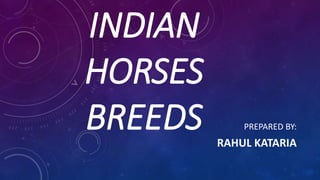INDIAN HORSE BREEDS, INDIAN PONY BREEDS, HORSES, PONIES
- 1. INDIAN HORSES BREEDS PREPARED BY: RAHUL KATARIA
- 2. HORSE (SCIENTIFIC CLASSIFICATION): Scientific name : Equus caballus 1. KINGDOM : ANIMALIA 2. PHYLUM : CHORDATA 3. CLASS : MAMMALIA 4. ORDER : PERISSODACTYLA 5. FAMILY : EQUIDAE 6. TRIBE : EQUINI 7. GENUS : EQUUS
- 3. HORSES(INDIAN) SLOW MOVING FAST RUNNING PACK PONIES SADDLE HORSES These are used for packing, These are used for riding, transportation of materials. Games, shows, beauty (found mainly in hilly areas) purposes etc.
- 4. 1. MARWARI HORSES: Native tract – RAJASTHAN (Marwar & Mewar region of Rajasthan viz. Udaipur, Jodhpur, Pali , Jalore, Barmer etc.) • Mainly reared for riding, sports and safari . • Predominant body color = BROWN • Other body colors are = ROAN, CHESTNUT, WHITE & BLACK with white patches. • The Marwari horses are longer and taller than Kathiawari horses. • Average dimensions - 130-140 cm long body, 152-160 cm height, 166-175 cm heart girth, 60 cm face length, 22 cm face width, 18 cm ear length and 47 cm tail length without switch.
- 6. 2. KATHIAWARI HORSES: Native tract – GUJARAT (Saurashtra province which comprises of Rajkot, Bhavnagar, Surendranagar, Junagarh and Amreli districts of Gujarat.) • Prominent color = CHESTNUT followed by BAY (body chestnut, Foreleg up to knee and fetlock are black, Keshwali black, Hairs of tail and neck are black), grey (complete white color) and dun (light chestnut). • These horses are concave profile, long neck, short leg and squared quarters. • Face is dry and short, triangular from pale to forehead and small muzzle, big nostrils, edge of nostril is thin; small, fine and curved upright ears on 90 degrees axis that can rotate at 180 degrees, broad forehead and large expressive sensitive eyes. • Mainly reared for riding, sports and safari .
- 8. 3. SPITI HORSES: Native tract – HIMACHAL PRADESH (Spiti valley and adjoining areas of Kullu and Kinnaur divisions of HP). • The spiti ponies have 2 strains 1. Spiti pure 2. Konimare • The Konimare ponies are comparatively taller. • Konimare ponies are capable of thriving in cold regions under adverse conditions of scarcity of food, low temperature and long journeys at high altitude. • The Spiti horses are used for riding and as pack animals.
- 9. CONTINUE.. • The predominant body color is grey / complete white followed by black, black flay bone (white body with black patches), brown and bay. • The Spiti horses are hardy and surefooted. • Body is well developed with fairly strong bones. • The legs are thick and covered with long coarse hairs. • The mane is longer having 20 to 30 cm long hairs. • Solid and compact body, convex face, erect ears, black eyes, straight back, long and straight tail, alert looking and short height (imp. Characteristics) • The horses are nervous in temperament.
- 10. SPITI HORSES
- 11. 4. ZANSKARI HORSES: Native tract – JAMMU AND KASHMIR (Leh and Laddakh) • The predominant body color is grey followed by black and copper. • Used for ability to work, transport (carry loads at high altitude) and for riding purpose. • The Zanskari horses have predominant eyes, heavy and long tail and uniform gait. • Large scale breeding with non descript ponies has endangered this breed. • The A.H. department (J&K) has established a Zanskari horse Breeding farm at Padum (Zanskar) in Kargil district of Laddakh for breed improvement and conservation through selective breeding.
- 12. ZANSKARI HORSES
- 13. 5. MANIPURI HORSES: Native tract – MANIPUR and ASSAM • Manipuri breed of ponies is one of the purest and prestigious breed of equines of India. • It is a strong and hardy breed and has very good adaptability to extreme geo- climatic conditions. • Oldest polo pony breed of India. • Manipuri horses have well developed shoulder, short back, well developed quarters and strong limbs. • Mane is generally coarse and upright. • Manipuri horses have small pointed ears, eyes are alert and slightly slant .
- 14. CONTINUE.. • The area between the nostrils is flat. • Face is concave and tail is well set and commensurate with height. • Manipuri ponies are intelligent and extremely tough, and have tremendous endurance. • The breed is available in 14 different colors viz. Bay, Black, Gray, Mora white, Leiphon white, Sinai White, Stocking, liver chestnut, Roan, light gray, Reddish brown and dark bay etc. • Significant role in war and games. • Number of Manipuri ponies decreasing rapidly, day by day . A big matter to worry!
- 15. MANIPURI HORSES
- 16. 6. BHUTIA HORSES: Native tract – SIKKIM,DARJEELING and ARUNACHAL PRADESH • Resemble to Tibetian pony. • They are usually grey or bay colored. • Bhutia horses are generally used for riding and pack animals. • Bhutia horses have large head, small eyes and ears, straight shoulder, deep chest, strong legs, short and muscular neck and have powerful hindquarters.
- 17. BHUTIA HORSES
- 18. 7. KACHCHHI-SINDHI HORSES: Native tract – GUJARAT (Kachchh) and RAJASTHAN (Jaisalmer & Barmer). • Roman nose appearance of face (unique character) , ears curved at tips but not touching each other. • Predominant coat color is Bay & chestnut. • Nose bone of these horses is raised at its middle and dropping sharply at the end of nostrils may be called parrot nose. • These horses are famous for their Rewal Chaal. • These horses posses excellent drought and heat tolerance capacity in arid & semi arid region.
- 20. SOURCES 1.NBAGR (National Bureau of Animal Genetic Resources) , Karnal (Haryana) , INDIA 2.NRCE ( National Research centre on Equines) , Sirsa road , Hisar (Haryana) , INDIA





















